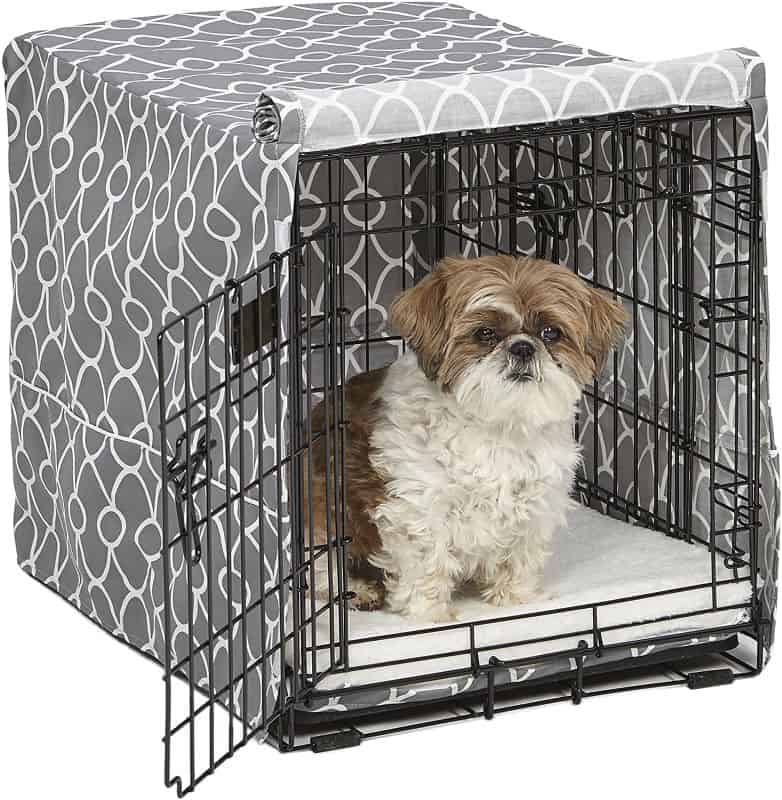When welcoming a new dog into your family, a common question is if you plan on crate training or not.
There are both pros and cons to using a crate to guide your dog’s behavior – and one size does not fit all for all households.
Let’s take a look into the benefits of crate training and also the reasons why it might not be the best option for you.
We’ll also dive into how long this type of training might last and alternatives to making sure your dog is the happiest (and most well-behaved) pup he or she can be.
But first here is a quick comparison before we go into more details…
Crate Training Pros and Cons Overview
Pros
- A crate keeps your dog away from harmful substances – and keeps your house in tip-top shape
- A crate can help with potty training a puppy
- Crates help make transportation easier
Cons
- It may cause physical and mental frustration to your dog – separation anxiety
- Crates can be dangerous
- Crates can also be misused
Where Can I Buy a Good Dog Crate?

Here are the best options from Chewy.com
Amazon.com has choices for all dog sizes
3 Benefits of Crate Training
1. A crate keeps your dog away from harmful substances – and keeps your house in tip-top shape.
While your puppy is learning the lay of the land, she will surely like to chew, sniff and play with any number of things that may harm her.
Or she may take a liking to using your shoes and bags as chew toys.
Keeping her crated while you’re away from the house will keep her – and your belongs – safe and sound.
2. A crate can help with potty training a puppy.
Naturally, dogs will not soil where they lay. As the crate becomes your dog’s safe place, it becomes a space that he knows not to defecate in.
If you start crate training immediately, it will set up obedient behaviors for life that lets your dog know not to relieve himself indoors.
By using the crate and taking your dog outside on a consistent basis, he begins to understand where it’s appropriate to go potty, which will help prevent accidents at night or when your dog is left alone.
3. Crates help make transportation easier.
There are times when crating your puppy will be unavoidable. If you crate train, your dog will not be afraid of it when it’s time to go to the vet, groomers or daycare.
In addition, if you travel regularly with your dog, his crate will provide him a place to feel comfortable while away from home.
Let your dog get comfortable with the kennel before travelling to ensure their safety and happiness.
What Kind of Crate Training Schedule Should I Follow?
A dog left too long in a locked crate may start to emotionally withdraw and become hyperactive because dog’s need to release energy by exercising and/or playing.
As puppies, they can only be left inside a crate for a small amount of time. As they grow, this time can be increased – but remember, less time is best for a happy, healthy dog.
With their small bladders, puppies under three months old need less than three hours inside a crate per day.
At 15-16 weeks old, you can allow an additional hour, up to 4 hours total.
After the age of 17 weeks, you can increase this to 5-6 hours maximum crate time.
If you must leave the house for a full 8-hour workday, consider hiring a dog walker to give your pup a bathroom break and short walk during the day, especially until you’re able to stop crate training.
Of course, this schedule is flexible based on how your dog handles being in the crate.
If your dog shows signs of stress and hyperactivity, lessen his time in confinement. Dogs need our care for more than just food and shelter, they need our love and attention as well.
When To Stop Crate Training
When to stop crate training depends on your dog’s personality and your schedule.
For example, if you have a docile Labrador who loves to sleep while you’re away, then you might be done with crate training as soon as he’s over his chewing phase, which is generally around 18 months of age.
On the other hand, if you have an easily excitable Terrier whose favorite pastime is tearing up your bed, blinds, anything – well, he might have to be crated for life while you’re away!
In general, if your dog doesn’t exhibit signs of separation anxiety, you can stop crate training around age 3 – and then let your dog have free reign on the home.
This is the age that most dogs can reasonably decipher between their toys and your belongings and should be long-ago housebroken.
If your dog does suffer from separation anxiety, she may never be fully trustworthy when left alone.
A behavior training specialist might be able to help overcome the issue.
It’s not enough to ensure your belongings won’t be damaged while pup is locked in her crate – her happiness is important as well, so training and working with your veterinarian is key.
If you work long hours and can’t afford to hire a dog walker for breaks throughout the day, you might consider stopping crate training around 1 year of age.
Instead, find a dog-proofed space in your home to block off – equipped with chew toys and water bowls.
If space allows, keep the crate in this area with its door open so your pup can use his bed for nap time.
Don’t quit cold turkey when you think you’re ready to give up the crate. Gradually increase the time that you’re away, to see how your dog manages on his own.
Consider letting your neighbors know, so they can alert you if they notice excessive barking – or that your window treatments are suddenly gone!
3 Reasons NOT to Crate Train
1. It may cause physical and mental frustration to your dog – separation anxiety.
If the crate is too small, your pup won’t be able to move to get comfortable. His limbs could also tire out if he’s not able to stand properly.
And the simple act of confinement and separation from you might send their anxiety into overdrive. Dogs with separation anxiety tend to panic when confined, which leads to the next con on our list.
Also, if your dog is stressed, he may constantly lick himself and create sores.
In addition, your dog may not take well to other humans or pets if he’s not given proper time to socialize. This is all a larger concern the longer your dog is left unattended in his closed crate.
2. Crates can be dangerous.
If the crate is not sturdy and durable, it could possibly collapse upon a dog and cause physical harm – especially if your dog tries to escape by banging on the sides or trying to scratch his way out.
Legs, ears, toenails are all capable of getting snagged on an escape-artist dog – and these physical injuries could cause major harm, as well as more mental stress.
Crates are also unsafe to use when your dog wears a collar or leash, which could get caught on the bars and cause your dog to be strangled.
Always remove your dog’s collar and leash before they’re allowed to be in their kennel unsupervised.
3. Crates can also be misused.
In a perfect world, no one would dream of abusing animals. But, sadly, we don’t live in a perfect world.
Some dog owners lock their dogs in crates for way too long, leaving their dogs to spend their days unloved, unhealthy, and unhappy.
This misuse of a crate isn’t actually training at all and can lead to major traumatization and distrust of humans.
4 Alternatives to Crate Training
If crate training doesn’t seem right for you, or the first tries didn’t go well for your dog, there are plenty of other options to create a happy, healthy family life with your dog.
1. Baby Gates
A baby gate is probably one of the easiest ways to confine your dog to a certain area of your house without having them cooped up in a crate. You can keep a blanket or dog bed and water bowls for them.
If you can close off an area with a hard-surface floor, even if they do have an accident, it will be easy to clean up.
And, you can still keep them away from household items that may harm them – and ones that you don’t want them to use as chew toys!
2. Exercise Pen
If you don’t have an easy way to close off an entire room with a baby gate, an exercise pen (also called “doggie playpen”) offers a spacious solution that’s more open than a crate.
It’s the same concept as the gate, just with creating a room of their own with the pen enclosure instead of closing off an existing one.
3. Fenced Yard
Weather permitting, if you have a well-secured, fenced backyard, you can consider keeping your dog outdoors.
Of course, this is best used if your dog is not a barker. You don’t want to ruin any relationship with your neighbors – and some cities have rules regarding how long a dog can be unattended outside, especially if they’re disturbing the peace.
4. Doggie Daycare
If you have the budget for doggie daycare, this option ensures that your dog has constant human care throughout the day – and doggie friends to play with.
Your dog will more than likely love the extra attention and be tired out from playing.
Then when you get home, you’ll be rewarded with extra snuggle time.
Wrapping It pUp
To crate train or not is a personal decision based on what works best for your household and your dog’s personality.
As long as you take the time to research the pros and cons, you can make an educated decision.
Think about…
Do you work long hours?
Can your dog handle being confined, or will that cause him anxiety?
Do you have the time to dedicate to crate training?

It’s not an easy task to undertake, but crate training can offer many benefits that can develop good behavior and help housebreak your pup.
This is not for everyone, though – especially if you work long hours or your dog gets extreme anxiety from being confined.
Luckily, there are alternatives that will work just as well. As long as you keep in mind your dog is not just your friend – he’s family and deserves to be treated as such!







